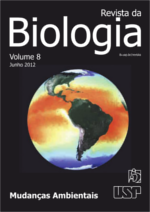Distribution of Rhinella granulosa: integrating bioclimatic envelopes and ecophysiological responses
DOI:
https://doi.org/10.7594/revbio.08.07Keywords:
Thermal tolerance, temperature gradient, BIOCLIM, species distribution modeling.Abstract
We used two modeling approaches (correlative and mechanistic) to build models of potential distribution of Rhinella granulosa. The model generated with several climatic variables (BIOCLIM1) was more conservative, a second with temperature only (BIOCLIM2) presented patches of discontinuous distribution and the mechanistic model indicated thermal habitats more suitable along an extensive continuous area. The BIOCLIM1 had more accuracy in predicting the potential distribution than BIOCLIM2. The BIOCLIM1 also had the best performance, followed by BIOCLIM2 and the mechanistic model. The difference among areas of potential distribution in models is probably due to the use of different predictor variables and may reflect limiting interespecific biotic interaction. These results provide basis for improving species distribution models.Downloads
Download data is not yet available.
Downloads
Published
2018-04-23
Issue
Section
Artigo
License
We ensure that our journal does not retain any copyright and that these are exclusive of the author(s) of the text. In that sense, we intend to break any restrictions to the published material and to achieve more intensely our goal of communicating science.
How to Cite
Cassemiro, F. A. S., Gouveia, S. F., & Diniz-Filho, J. A. F. (2018). Distribution of Rhinella granulosa: integrating bioclimatic envelopes and ecophysiological responses. Revista Da Biologia, 8(1), 38-44. https://doi.org/10.7594/revbio.08.07






